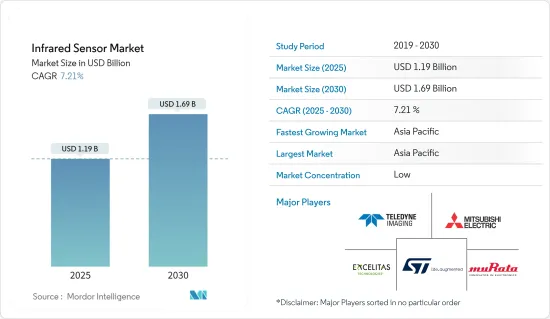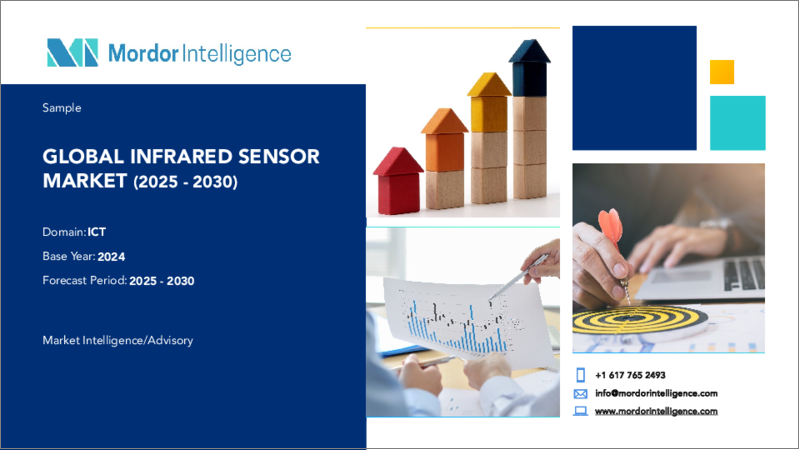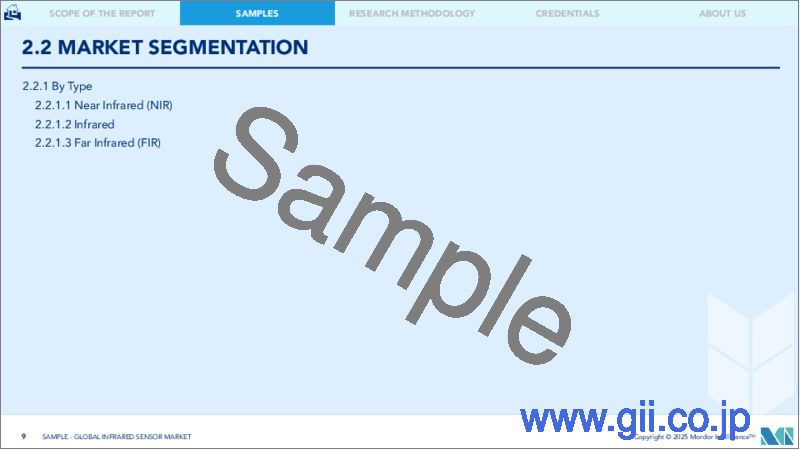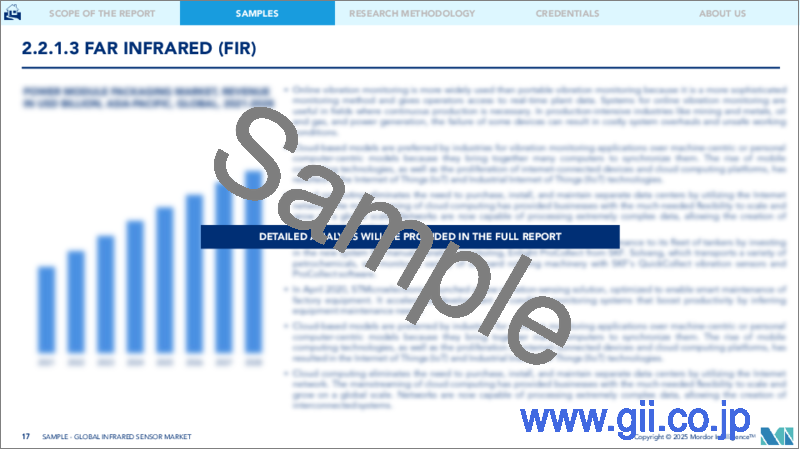|
|
市場調査レポート
商品コード
1641971
赤外線センサ:市場シェア分析、産業動向・統計、成長予測(2025~2030年)Infrared Sensor - Market Share Analysis, Industry Trends & Statistics, Growth Forecasts (2025 - 2030) |
||||||
カスタマイズ可能
適宜更新あり
|
|||||||
| 赤外線センサ:市場シェア分析、産業動向・統計、成長予測(2025~2030年) |
|
出版日: 2025年01月05日
発行: Mordor Intelligence
ページ情報: 英文 156 Pages
納期: 2~3営業日
|
全表示
- 概要
- 目次
赤外線センサ市場規模は2025年に11億9,000万米ドルと推定され、2030年には16億9,000万米ドルに達すると予測され、予測期間(2025~2030年)のCAGRは7.21%です。

赤外線(IR)センサは、780 nmから50μmまでのスペクトル感度を持ち、環境との相互作用を変化させ、さまざまな産業で不可欠なものとなっています。赤外線を検出することで、これらのセンサは明確な利点を提供し、幅広い採用につながっています。赤外線センサは、照明や警報システムを作動させるためにビルサービスで一般的に採用されているモーションディテクターで重要な役割を果たしています。これらのセンサは、特定の角度範囲内で、物体や個人の動きに起因する熱放射の時間的・空間的変化を検出します。
主要ハイライト
- 市場は、消費者向けスマートデバイスの需要急増に後押しされて拡大しています。自動車セグメントも成長しており、特にADASや衝突検知のような先進的安全性と利便性へのニーズが高まっています。医療セグメントでは、赤外線センサへの依存度が高まっており、脅威検出を強化するために航空宇宙や防衛セグメントでの採用が進んでいることも、市場の拡大をさらに後押ししています。
- 例えば、スマートホームデバイスの需要が急増しています。Consumer Technology Association(CTA)の予測では、米国のスマートホームデバイスの売上は2023年に235億米ドルに達します。IRベースのモーションセンサは、スマート照明システム、モニタリングシステム、自動ドアロックで重要な役割を果たしており、セキュリティとエネルギー効率の両方を高めています。このような動向は、今後数年間の採用を促進します。
- 医療産業では、患者のモニタリングや医療用画像処理など、さまざまな用途でIRセンサの採用が進んでいます。IRセンサによる非接触温度計測の重要性は世界の健康危機の際に強調されており、この動向はCOVID-19パンデミック後も続くと予想されます。IRセンサの非接触機能が二次汚染のリスクを軽減することを考えると、医療環境におけるその価値は否定できないです。この動向は、今後数年間、継続的な成長の舞台となります。
- IRセンサの技術的限界は、調査対象市場の成長にとって大きな課題となっています。例えば、赤外線周波数は、壁やドアのような固形物や、埃、霞、太陽光の影響を受ける可能性があります。スクリーンや制御用途では、IRセンサは一度に1つのデバイスしか管理できないため、直接視線の外にあるものを制御するのは難しいです。
- 世界のサプライチェーンはすでに、輸送コストの高騰、インフレの継続、労働力不足の継続、必需品の不足、需要の変動など、数多くの課題に取り組んでいます。不況はこれらの問題をさらに悪化させると考えられます。潜在的な景気後退の正確な時期や強度を特定することは依然として困難であるが、企業はこれらの影響について洞察することで、サプライチェーンへの影響によりよく備えることができます。予測期間は楽観的で、ほとんどの経済と産業部門が勢いを取り戻すと予想され、調査した市場に機会をもたらしています。
赤外線(IR)センサ市場動向
自動車産業がエンドユーザーとして急成長
- 技術の進歩により自動車市場の競争が激化する中、消費者は安全性や信頼性の向上、全体的に優れた運転体験を約束する自動車を優先する傾向が強まっています。このような消費者の関心の高まりが自律走行車の開発に拍車をかけ、自動車セグメントにおける電子デバイスの需要を促進しています。課題は、センシング、処理、起動、フィードバック、制御機能において、人間の脳の能力をエレクトロニクスに置き換えることにあり、これは爽快かつ困難な課題です。
- 1905年以来、自動車の規格を定めているアメリカの技術者団体である自動車技術会(SAE)は、自動車の自律性を6段階に分類しています。米国エネルギー情報局によると、レベル5の自律性は完全な自動化を意味し、車両があらゆる条件下ですべての運転機能を効率的に実行できることを意味します。これには、悪天候や夜間の状況下での自律運転も含まれます。このようなシナリオが頻繁に自動車事故につながることを考えると、このような効果的な認識は極めて重要です。
- FIRの卓越性は、さまざまな照明条件下で一貫した画像を生成することにも及びます。通常のCMOS画像とは異なり、物体の色、背景、照明の方向、複数の光源、鏡面反射、その他の照明による異常の影響を受ける可能性があります。FIR画像は不変です。
- 例えば、CMOSカメラは車線や道路標示を巧みに検出しますが、視覚的な不一致が大きいため、白昼でも走行可能な道路領域をピンポイントで検出することに失敗することがよくあります。対照的に、FIR画像は多様な照明シナリオにわたって一貫した道路外観を維持します。この一貫性は自律走行車にとって最も重要であり、自律走行車は生きているものにも生きていないものにも対応するために必要な明瞭さで環境を認識することができます。
- 世界市場ではプラグ電気自動車(PEV)の需要が急増しています。国際エネルギー機関(IEA)によると、2023年には約1,370万台のプラグイン電気自動車(PEV)が販売されるといいます。電気自動車の人気が急上昇していることは、市場の魅力を強調し、その有望な成長展望を浮き彫りにしています。先進的な熱電対と赤外線センサは、インバータパワーエレクトロニクス全体の温度勾配を測定し、熱平衡を確保し、EVモーターの寿命を延ばす上で極めて重要な役割を果たしています。
大きな成長を記録するアジア太平洋
- アジア太平洋には、日本、韓国、中国、台湾の企業を含む世界最大級の民生用電子機器メーカーがあります。赤外線センサの需要増加は、顔認識、近接検知、遠隔操作などの用途でスマートフォン、タブレット、その他のスマートデバイスに使用されることが原動力となっています。
- この地域における赤外線センサ(IRセンサ)の需要は、自動車・運輸、再生可能エネルギー、赤外線センサ(IR)を多用するその他の産業など、さまざまなセグメントの進歩により高まっています。例えば、最も著名な自動車生産国である中国の大規模な自動車製造規模は、IRセンサの高い需要に寄与しています。何百万台もの自動車に先進的センシング技術を搭載する必要があるため、IRセンサの市場が拡大しています。
- 中国の新エネルギー自動車産業開発計画(2021~2035年)によると、電気自動車は2025年までに25%の市場シェアを獲得する可能性があります。そのため、中国は電気自動車の普及を促進するため、より積極的な施策を実施しており、その結果、電気自動車で幅広く利用されるディスクリート半導体の採用が加速しています。
- 2023年8月、CAAMは、中国が58万9,000台のバッテリー電気自動車(BEV)を製造したと報告しました。その内訳は、乗用車用BEVが55万1,000台、商用BEV(バッテリー電気自動車)が3万8,000台でした。さらに同月、中国では25万4,000台のプラグインハイブリッド車(PHEV)が生産され、そのうち25万3,000台が乗用PHEV、1,000台が商用PHEVでした。
- 2024年6月、GalaxEye Spaceは、国防省傘下のイニシアチブであるiDEX DIOと提携し、新しいマルチセンサ融合処理システムを構築しました。このシステムは、特にインド空軍(IAF)向けに、150kgまでの複数のペイロードを搭載する小型衛星向けに設計されています。この先進的システムは、まず赤外線センサからのデータを処理し、それを地上局に中継します。
赤外線(IR)センサ産業概要
赤外線センサ市場はセグメント化されており、競合が激しいです。激しい競争を維持するため、地域企業は主要な成長戦略として高コストの研究開発、パートナーシップ、提携、買収を採用しています。同市場の主要企業は、Murata Manufacturing、STMicroelectronics NV、Excelitas Technologies、Teledyne Imaging Inc.、Mitsubishi Electric Corporationなどがあります。
- 2024年4月:InfraTec GmbHは、2年半という短期間で実現した新社屋の完成を発表しました。新社屋が稼動したことで、同社は既存施設の改修に着手しました。2,700平方メートルの広大な敷地は、最先端のサーモグラフィ・カメラと赤外線検出器の生産と開発に使用されます。
- 2023年11月HydrosatとMuon Spaceは戦略的パートナーシップを締結し、HydrosatのCaaS(Constellation-as-a-Service)宇宙船の契約締結に至った。Hydrosatの最先端のマルチスペクトルと熱赤外(IR)イメージング機器を搭載することが期待されるこのコラボレーションは、低軌道(LEO)に小型衛星のコンステレーションを展開するというHydrosatのビジョンを大きく前進させています。これらの衛星は、気候変動により淡水不足が深刻化する中、農業における水利用効率を高める重要なデータを提供することを目的としています。
その他の特典
- エクセル形式の市場予測(ME)シート
- 3ヶ月間のアナリストサポート
目次
第1章 イントロダクション
- 調査の前提条件と市場定義
- 調査範囲
第2章 調査手法
第3章 エグゼクティブサマリー
第4章 市場洞察
- 市場概要
- 産業の魅力-ポーターのファイブフォース分析
- 供給企業の交渉力
- 買い手の交渉力
- 新規参入業者の脅威
- 代替品の脅威
- 競争企業間の敵対関係の強さ
- マクロ経済動向の市場への影響
第5章 市場力学
- 市場促進要因
- 産業セットアップにおけるワイヤレス技術と自動化技術の採用増加
- ホームオートメーション製品とスマートデバイスの需要拡大
- 市場課題
- 技術的限界と製造の複雑化
第6章 市場セグメンテーション
- タイプ別
- 近赤外線(NIR)
- 赤外線
- 遠赤外線(FIR)
- エンドユーザー産業別
- 医療
- 航空宇宙・防衛
- 自動車
- 商業用途
- 製造業
- 石油・ガス
- その他
- 地域別
- 北米
- 欧州
- アジア
- オーストラリア・ニュージーランド
- ラテンアメリカ
- 中東・アフリカ
第7章 競合情勢
- 企業プロファイル
- Murata Manufacturing Co. Ltd
- STMicroelectronics NV
- Excelitas Technologies
- Teledyne Imaging Inc.
- Mitsubishi Electric Corporation
- Amphenol Advanced Sensors(Amphenol Corporation)
- SENBA Sensing Technology Co. Ltd
- Nippon Ceramic Co. Ltd
- Panasonic Corporation
- Broadcom Inc.
- Melexis NV
- Hamamatsu Photonics kk
- InfraTec GmbH
第8章 投資分析
第9章 市場の将来
The Infrared Sensor Market size is estimated at USD 1.19 billion in 2025, and is expected to reach USD 1.69 billion by 2030, at a CAGR of 7.21% during the forecast period (2025-2030).

Infrared or IR sensors, with a spectral sensitivity ranging from 780 nm to 50 µm, have become indispensable across diverse industries, transforming interactions with the environment. By detecting infrared radiation, these sensors provide distinct advantages, leading to their broad adoption. IR sensors play a pivotal role in motion detectors, commonly employed in building services to activate lamps or alarm systems. Within a specified angular range, these sensors detect temporal and spatial changes in heat radiation attributed to the movement of objects or individuals.
Key Highlights
- The market is expanding, fueled by the surging demand for smart consumer devices. The automotive sector is also growing, particularly with the rising need for advanced safety and convenience features like ADAS and collision detection. The healthcare sector's increasing reliance on IR sensors, along with their adoption in aerospace and defense for enhanced threat detection, further propels the market's expansion.
- For instance, the demand for smart home devices has surged. Estimates from the Consumer Technology Association (CTA) projected that revenue from smart home devices in the United States would hit USD 23.5 billion in 2023. Given that IR-based motion sensors play a pivotal role in smart lighting systems, surveillance systems, and automated door locks, boosting both security and energy efficiency. These trends are set to propel their adoption in the coming years.
- The healthcare industry is increasingly adopting IR sensors for diverse applications, including patient monitoring and medical imaging. The significance of non-contact temperature measurement via IR sensors has been underscored during global health crises, and this trend is expected to persist even after the COVID-19 pandemic. Given that the contactless functionality of IR sensors mitigates the risk of cross-contamination, their value in healthcare settings is undeniable. This trend sets the stage for continued growth in the coming years.
- Nonetheless, the technical limitations of IR sensors pose significant challenges to the growth of the market studied. For example, infrared frequencies can be affected by solid objects like walls and doors, as well as by dust, haze, and sunlight. In screen and control applications, IR sensors can only manage one device at a time, making it challenging to control items outside their direct line of sight.
- Global supply chains are already grappling with numerous challenges, such as soaring transportation costs, persistent inflation, ongoing labor shortages, a shortage of essential goods, and fluctuating demand. A recession would only exacerbate these issues. While pinpointing the exact timing and intensity of a potential recession remains elusive, organizations can better prepare for its ramifications on supply chains by gaining insights into these impacts. Nevertheless, the forecast period looks optimistic, with most economies and industrial sectors expected to regain momentum, presenting opportunities in the market studied.
Infrared (IR) Sensor Market Trends
Automotive Industry to be the Fastest Growing End User
- As competition within the automotive market intensifies due to technological advancements, consumers increasingly prioritize vehicles that promise enhanced safety, reliability, and an overall superior driving experience. This heightened consumer interest has spurred the development of autonomous vehicles, propelling the demand for electronic devices within the automotive sector. The challenge lies in replacing the capabilities of the human brain in sensing, processing, activation, feedback, and control functions with electronics, which is an exhilarating and daunting task.
- The Society of Automotive Engineers (SAE), an American engineering group setting automotive standards since 1905, outlines six levels of vehicle autonomy. According to the US Energy Information Administration, Level 5 autonomy signifies full automation, which means a vehicle can efficiently perform all driving functions under all conditions." This encompasses operating autonomously in adverse weather and nighttime conditions. Such effective perception is vital, given these scenarios frequently lead to vehicular accidents.
- FIR's prowess extends to producing consistent images under varying lighting conditions. Unlike regular CMOS images, which can be influenced by an object's color, background, illumination direction, multiple light sources, specular reflections, and other lighting-induced anomalies. FIR images remain steadfast.
- For example, while CMOS cameras adeptly detect lanes and road markings, they often falter in pinpointing the drivable road area even in broad daylight due to significant visual discrepancies. In contrast, FIR images maintain a consistent visual road appearance across diverse lighting scenarios. This consistency is paramount for autonomous vehicles, ensuring they perceive their environment with the clarity needed to respond to both living and non-living entities.
- The global market is witnessing a surging demand for plug-electric vehicles (PEVs). According to the International Energy Agency (IEA), approximately 13.7 million plug-in electric light vehicle (PEV) units were sold in 2023. Electric vehicles' burgeoning popularity underscores their market appeal and highlights their promising growth prospects. This is particularly evident as advanced thermocouples and infrared sensors play a pivotal role in measuring temperature gradients across inverter power electronics, ensuring thermal equilibrium and prolonging EV motors' lifespan.
Asia-Pacific to Register Major Growth
- The Asia-Pacific region is home to some of the largest consumer electronics manufacturers globally, including companies in Japan, South Korea, China, and Taiwan. The rising demand for IR sensors is driven by their use in smartphones, tablets, and other smart devices for applications like facial recognition, proximity sensing, and remote.
- The demand for infrared sensors (IR sensors) in the region is rising owing to advancements in various sectors such as automotive & transportation, renewable energy, and other industries that utilize Infrared sensors (IR) extensively. For instance, as the most prominent automotive producer, China's massive vehicle manufacturing scale contributes to the high demand for IR sensors. The need to equip millions of vehicles with advanced sensing technologies creates a substantial market for IR sensors.
- According to China's Development Plan for the New Energy Automobile Industry (2021-2035), electric vehicles could capture a 25% market share by 2025. Consequently, China is implementing more assertive measures to incentivize the adoption of electric vehicles, thereby expediting the adoption of discrete semiconductors for their extensive utilization in EVs.
- In August 2023, CAAM reported that China manufactured 589,000 battery electric vehicles (BEVs), comprising 551,000 passenger BEVs and 38,000 commercial BEVs (battery electric vehicles). Additionally, 254,000 plug-in hybrid electric vehicles (PHEVs) were produced in China during the same month, with 253,000 being passenger PHEVs and 1,000 being commercial PHEVs.
- In June 2024, GalaxEye Space partnered with iDEX DIO, an initiative under the Ministry of Defence, to create a new multi-sensor fusion processing system. This system is designed for compact satellites that accommodate multiple payloads weighing up to 150kg, specifically for the Indian Air Force (IAF). The advanced system will first process data from infrared sensors and then relay it to ground stations.
Infrared (IR) Sensor Industry Overview
The infrared sensor market is fragmented and highly competitive. To sustain intense competition, regional companies adopt high-cost research and development, partnerships, collaborations, and acquisitions as their prime growth strategies. Key players in the market are Murata Manufacturing Co. Ltd, STMicroelectronics NV, Excelitas Technologies, Teledyne Imaging Inc., Mitsubishi Electric Corporation, and many more.
- April 2024: InfraTec GmbH proudly announced the completion of its new extension building, a project realized in a swift two and a half years. With the new structure now operational, the company has turned its attention to renovating the existing facility. The enhancements boast a vast 2,700 m2 area dedicated to the production and development of cutting-edge thermography cameras and infrared detectors.
- November 2023: Hydrosat and Muon Space entered into a strategic partnership, culminating in a contract for Hydrosat's debut Constellation-as-a-Service (CaaS) spacecraft. Anticipated to be equipped with Hydrosat's state-of-the-art multispectral and thermal infrared (IR) imaging instruments, this collaboration significantly advances Hydrosat's vision of deploying a constellation of small satellites in Low Earth Orbit (LEO). These satellites aim to provide crucial data, enhancing water use efficiency in agriculture, a pressing need given the rising freshwater scarcity exacerbated by climate change.
Additional Benefits:
- The market estimate (ME) sheet in Excel format
- 3 months of analyst support
TABLE OF CONTENTS
1 INTRODUCTION
- 1.1 Study Assumptions and Market Definition
- 1.2 Scope of the Study
2 RESEARCH METHODOLOGY
3 EXECUTIVE SUMMARY
4 MARKET INSIGHTS
- 4.1 Market Overview
- 4.2 Industry Attractiveness - Porter's Five Forces Analysis
- 4.2.1 Bargaining Power of Suppliers
- 4.2.2 Bargaining Power of Buyers
- 4.2.3 Threat of New Entrants
- 4.2.4 Threat of Substitute Products
- 4.2.5 Intensity of Competitive Rivalry
- 4.3 Impact of Macroeconomic Trends on the Market
5 MARKET DYNAMICS
- 5.1 Market Drivers
- 5.1.1 Rising Adoption of Wireless and Automated Technologies in Industrial Setups
- 5.1.2 Growing Demand for Home Automation Products and Smart Devices
- 5.2 Market Challenges
- 5.2.1 Technological Limitations and Increasing Manufacturing Complexity
6 MARKET SEGMENTATION
- 6.1 By Type
- 6.1.1 Near Infrared (NIR)
- 6.1.2 Infrared
- 6.1.3 Far Infrared (FIR)
- 6.2 By End-user Industry
- 6.2.1 Healthcare
- 6.2.2 Aerospace and Defense
- 6.2.3 Automotive
- 6.2.4 Commercial Applications
- 6.2.5 Manufacturing
- 6.2.6 Oil and Gas
- 6.2.7 Other End-user Industries
- 6.3 By Geography
- 6.3.1 North America
- 6.3.2 Europe
- 6.3.3 Asia
- 6.3.4 Australia and New Zealand
- 6.3.5 Latin America
- 6.3.6 Middle East and Africa
7 COMPETITIVE LANDSCAPE
- 7.1 Company Profiles
- 7.1.1 Murata Manufacturing Co. Ltd
- 7.1.2 STMicroelectronics NV
- 7.1.3 Excelitas Technologies
- 7.1.4 Teledyne Imaging Inc.
- 7.1.5 Mitsubishi Electric Corporation
- 7.1.6 Amphenol Advanced Sensors (Amphenol Corporation)
- 7.1.7 SENBA Sensing Technology Co. Ltd
- 7.1.8 Nippon Ceramic Co. Ltd
- 7.1.9 Panasonic Corporation
- 7.1.10 Broadcom Inc.
- 7.1.11 Melexis NV
- 7.1.12 Hamamatsu Photonics kk
- 7.1.13 InfraTec GmbH





